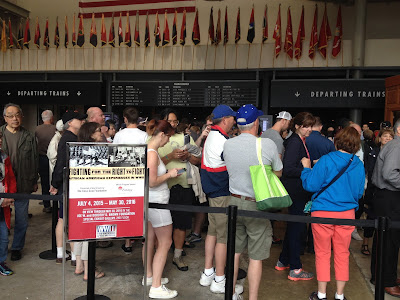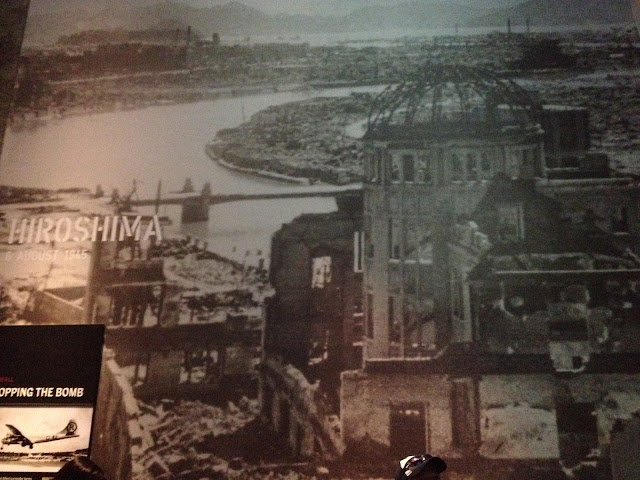We arrived late in the morning and stood in line for tickets with a few hundred of our fellow tourists. In the background, you can see the old-fashioned train departure/arrival board, with "clicking" letter/number changes that are done mechanically.
There were some interesting things to see while we waited in line….
Above all of us in line hung a real World War II bomber. We were getting bored with the line thing until we realized we were standing right under the airplane!
The museum experience is staggering. Two movies are offered to supplement the tour, and came highly recommended, but we didn't have the time. May have to go back. The museum itself is divided into essentially three sections: the Pacific Theater, the European Theater, and a completely separate building sponsored by Boeing that highlights aircraft used during the war. The entire museum experience is designed to provide an in-depth look at The War without overloading the visitor with details. Seriously wonderful audio/visual tools are used in a diorama setting to give the visitor a sense of "being there", with smaller exhibits of a more personal level that humanize The War. Beautifully designed, and exceptionally well done.
After getting an introduction to the museum by boarding a "train" that immersed us in the emotion of young men and women going off to war, leaving friends and family behind, and not knowing if they would return. We were each given a "dog tag" that introduced us to a particular person that fought in the conflict. Donna's hero was a 15 year-old sailor and mine was a local New Orleans boy who sailed in the Merchant Marine. As soon as we exited the train, we toured an exhibit that showed us what an important job the Merchant Marine performed. Dangerous and hard, these mariners braved enemy submarines and foul weather to bring supplies to the fighting on the front. Without these Merchant Mariners, food, gas, clothes, toothbrushes, airplanes, and ammunition would have not reached their destination, and the war would have been lost. It's all about logistics and supply lines.
Then we chose to enter the Pacific Theater area, because we have a family connection to that area and time, and were sent immediately into the Green Hell that was Guadalcanal.
The taking of Guadalcanal marked the beginning of the end of Japanese Empirical expansion in the Pacific. This map outlines the extent of the Japanese Empire.
New methods had to be developed to fight a war in conditions that the Allies were not familiar with. General Douglas MacArthur initiated the concept of "leapfrogging" islands instead of fighting for each one. This saved men and material and left the enemy to lose any hope of rescue and resupply.
A little known "second front" of the war in the Pacific is the effort in China, Burma, and India. Heroic measures were employed to get supplies to the resistance fighters in Southeast Asia. Japanese occupation armies committed unspeakable atrocities during occupation, and resistance was minimal, but could not be ignored. US engineers built airfields, roads, and supply depots in support of the effort.
Lieutenant General Chennault was placed in command of the famous "Flying Tigers" that performed such miraculous feats in support of the Southeast Asia campaign.
A particularly moving exhibit included two telegrams to Mrs. Grace Howell of Texarkana, TX. The first notified her that her son was missing in action.
And the second was the telegram that no one wants to receive.
As we walked through the museum, we read stories of the people involved.
The story we all know:
Perhaps it's fitting that we found out the definition of "Gung Ho": "Work Together".
In the European exhibit, we saw a map of the extent of the Third Reich. Unfortunately, my camera would not include the North African segment.
Many courageous men lost their lives over Europe, but many survived as heroes.
I didn't know that Kurt Vonnegut was a soldier in WWII.
It was interesting to note the origin of the "Jerry Can".
This 1934 Opel sedan is one of several captured at the end of the war. Military vehicles were in short supply, so civilian vehicles, if any, were pressed into service. Camouflaged with whitewash and branches, and with the headlights painted over, these sturdy little sedans transported high ranking Nazis.
Several last ditch "lines" were established by the Germans, one of which was the Siegfried Line. These soldiers deserve our praise for their sacrifices.
In the Boeing Center, a Boeing B17E Flying Fortress hangs from the ceiling. The planes nickname "My Gal Sal" was abandoned in 1942 in Greenland after an emergency landing. It was retrieved in recent years and brought to the Museum. Other than cleaning, it is presented exactly as it was found after 70 years on the Greenland Ice.
Since the WWII Museum is located very near the French Quarter in NOLA, we just had to cruise through on our way home!
On Decatur St, we found a small grocery that has a famous item for sale.
We've been to Central Grocery in the past, and found that the Muffuletta's are special. Made with various kinds of salami, spread with olive salad, and drizzled with olive oil and served on Italian hard crust bread, it is delicious! Connoisseurs will ask for sandwiches that have been made a few hours so that the olive oil has a chance to permeate the bread. Indeed, they had several sandwiches pre made and wrapped in butcher paper on the counter behind the cash register, so that's what we got! Delicious! We were prepared to bring the sandwiches home, but elected to eat at the back counter, the back wall of which is decorated with signatures of thousand of customers.
Again, New Orleans fascinates. The city never fails to offer a new and unusual experience!
























What an interesting day!
ReplyDelete